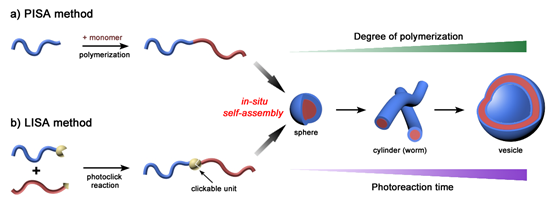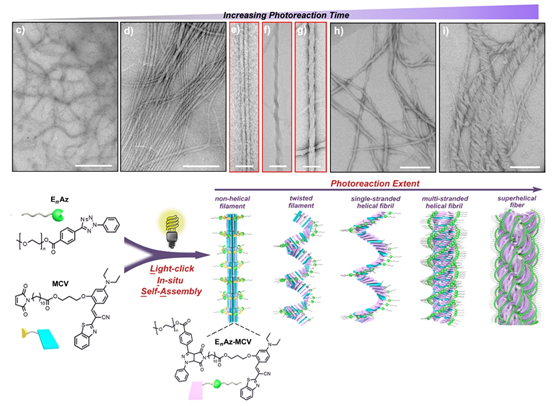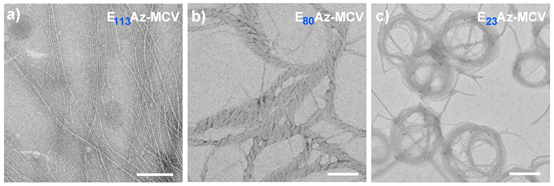 +565 975 658
+565 975 658
 info@premiumcoding.com
info@premiumcoding.com
 Monday - Friday, 8.00 - 20.00
Monday - Friday, 8.00 - 20.00
Helix is the most aesthetic and fundamental structural element in nature. Studying on the helical self-assembly can not only help us understand the formation of natural chirality, but also provide us with effective methods for preparing chiral sensors, chiral catalysts, and chiral optical devices. However, the classical solution processing technique for chiral nanostructures is prepared by a post-self-assembly strategy, that is, we need to first synthesize and purify building block and subsequently dissolve them in selective solvents to form nano-objects, which limits on high-dilution concentration and require tedious multistep procedures.
In recent years, researchers have turned sight to in-situ self-assembly. This strategy allows the polymerization and macromolecules self-assembly to occur simultaneously, which can not only circumvent tedious synthesis and solution-processing procedures in post-self-assembly strategy, but also allows us to adjust the morphology of self-assembly by adjusting the polymerization parameters (such as reaction time, the degree of polymerization, etc.). Among these, polymerization-induced self-assembly (PISA) is the most representative method. Using this method, we can rapidly prepare a wide variety of polymer nanoparticles on a large scale, such as spherical micelles, worm-like micelles, vesicles, and even inverse mesophases. However, using this method is difficult to directly create superstructures, such as helixes or superhelixes.

Figure 1. Schematic illustration of the synthesis of diblock copolymer nanoobjects through (a) Polymerization-induced self-assembly (PISA) method and (b) Light-click in-situ self-assembly (LISA) method.
Recently, Yan’s group at Fudan University has developed a second in situ self-assembly technique, named as Light-Click in-Situ Self-Assembly (LISA). This strategy requires only two homopolymers terminated with photo-click groups as precursors, which can guide the coupling reaction between the precursors and the assembly process of the product simultaneously, and sequentially construct polymer assembly morphology and regulate the evolution process of phase structure through photoreaction time (Figure 1). Four years ago, the research group successfully used the LISA strategy to obtain the in-situ assembly of spherical micelles, worm-like micelle and vesicles (Macromolecules 2017, 50, 4276-4280). Now, this team extended this strategy to the construction of the helical superstructures. As shown in Figure 2, these superstructures exhibit typical left-handed helicity (M-type) with a pitch of 68 nm and a helix angle of 62°, and are composed of multiple right-handed helical nanofibrils with a pitch of 30 nm and a helix angle of 42°.

Figure 2. The LISA method was used to directly construct helical nanofibers with E45Az and MCV as precursor molecules.
To study the formation mechanism of this superstructure, the researchers used TEM to track the evolution of the assembly morphology during the reaction. The results show that, as the reaction progresses, single non-helical nanofilaments are formed in the early stage of assembly, and then the filaments gradually shifted into single-stranded helical fibrils, and then intertwined into multi-stranded helical nanofibrils, eventually evolved into superhelical nanofibers. In-depth study found that this helix level can be precisely controlled by externally applied light time, the degree of light reaction is directly related to the helical structure of the assembly (Figure 3). Moreover, the structures of the self-assembly in these stages are thermodynamically stable, and the assembly process can be paused or restarted by opening and closing light stimulation.

Figure 3. TEM images tracking the LISA phase evolution for various times.
To further validate the universality of LISA strategy in the creation of helical objects, we tuned the chemical structure of the precursor and observed their self-assembled distinction (Figure 4). When decreasing the polyether length, a large amount of superhelical nanorings can be obtained. In contrast, increasing the polymerization degree of polyether, only non-helical nanofilaments can be accquired. This work paves a new way for the in-situ preparation and regulation of helixes or superhelixes.

Figure 4. TEM images showing the self-assembled distinction in LISA formulation caused by the molecular precursors with various PEO chain lengths: (a) E113Az and MCV, (b) E80Az and MCV, (c) E23Az and MCV.
The work was published in Macromolecules with Liang Chen as first authors, Professor Qiang Yan as the corresponding authors. Liang Chen, Xuefeng Li, and Qiang Yan*. Light-Click In Situ Self-Assembly of Superhelical Nanofibers and Their Helicity Hierarchy Control. Macromolecules 2021, doi.org/10.1021/acs. macromol.1c00197. Link https://pubs.acs.org/doi/10.1021/acs.macromol.1c00197
Get to know us better now!

Wechat:FDUMMers
Search!
Search across our website
Revenant @ 2018 by fudan | All Rights Reserved
Powered by Weicheng

